A Traveler’s Guide to Qianling Mausoleum: Discovering Ancient Chinese Culture
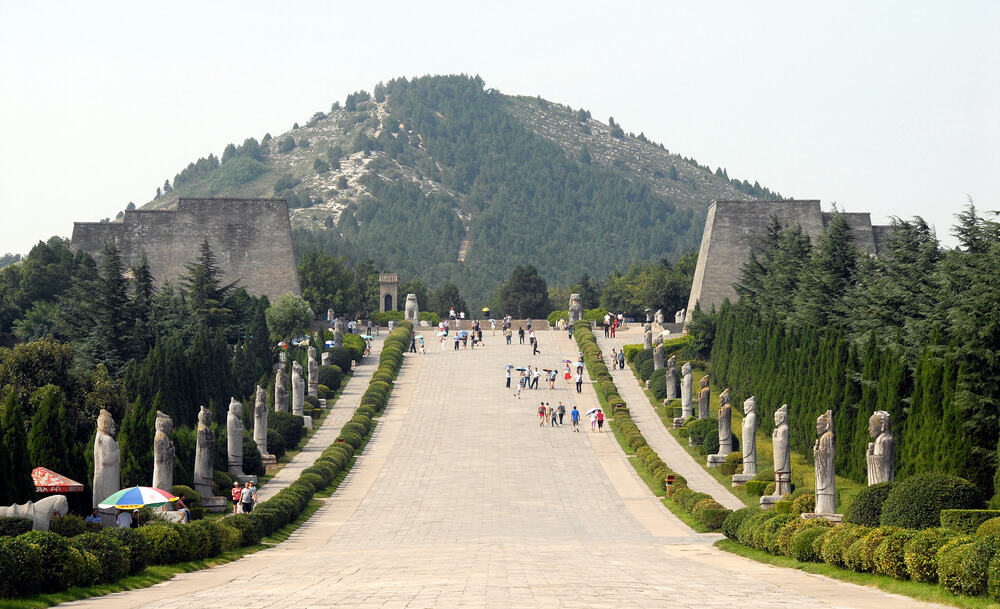
An Essential Guide to Visiting Qianling Mausoleum Scenic Area
In This Guide
- An Essential Guide to Visiting Qianling Mausoleum Scenic Area
- The Rich History and Legends of Qianling Mausoleum Scenic Area
- Main Highlights: What You Absolutely Can’t Miss
- Planning Your Visit: A Practical Guide
- Tickets: Prices, Booking, and Tips
- How to Get There: A Complete Transportation Guide
- Local Cuisine and Accommodation Nearby
- Frequently Asked Questions
- Final Thoughts on Your Trip
The Qianling Mausoleum Scenic Area is a hidden gem nestled in the hilly landscape of Qian County, China, where history and nature intertwine to create a uniquely captivating experience. This site is not just a mausoleum; it is the final resting place of two of the most significant figures of the Tang Dynasty: the formidable Empress Wu Zetian and her husband, Emperor Gaozong. As the only female emperor in Chinese history, Wu Zetian’s life story is one of ambition, intelligence, and remarkable power, making her tomb a must-see for those interested in the intricate tapestry of Chinese history and culture.
When you visit the Qianling Mausoleum Scenic Area, you will be stepping into a realm that echoes the grandeur of the Tang Dynasty, a period often celebrated for its cultural flourishing and imperial achievements. The mausoleum itself is an architectural marvel, surrounded by lush mountains and adorned with intricate stone statues that represent dignitaries and warriors from a bygone era. The spirit way, lined with headless statues and rich in symbolism, invites travelers to reflect on the legacies of those who once ruled.
What to Expect:
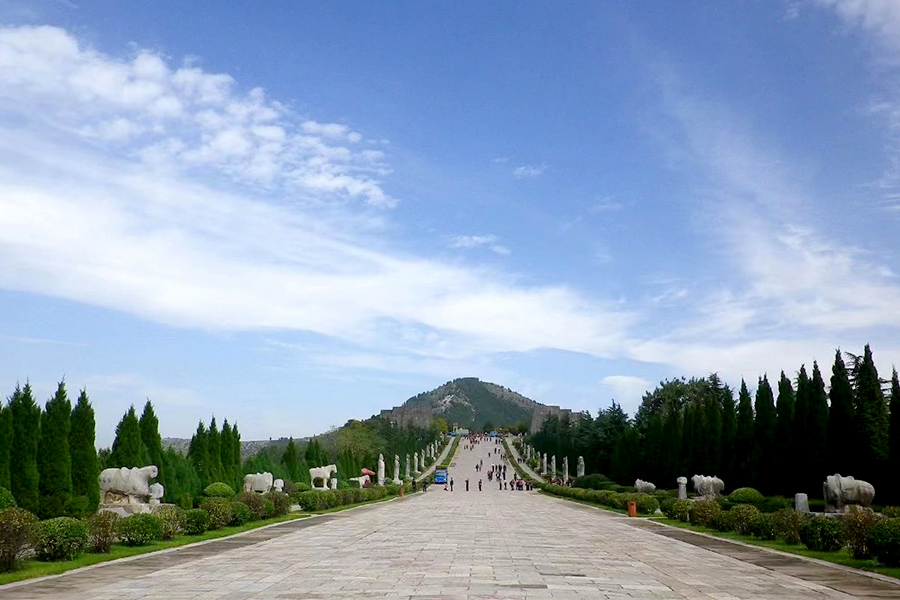
Qianling_Mausoleum_Scenic_Area.
- Stunning Natural Scenery: The scenic area boasts beautiful landscapes, providing ample opportunities for leisurely walks and photographs against the backdrop of the majestic mountains.
- Cultural Insights: The site is rich in history, and while a guide can enhance your understanding, researching Wu Zetian and the Tang Dynasty beforehand can deepen your appreciation for the mausoleum’s significance.
- Limited Crowds: Unlike many tourist hotspots in China, Qianling remains relatively uncrowded, allowing visitors to explore at their own pace and fully absorb the atmosphere of this historical sanctuary.
Whether you’re a history buff, a culture enthusiast, or simply seeking a tranquil escape, the Qianling Mausoleum Scenic Area offers a profound glimpse into China’s past, inviting you to walk in the footsteps of emperors and empresses. Prepare to be enchanted by the stories etched in stone and the breathtaking views that surround you.
The Rich History and Legends of Qianling Mausoleum Scenic Area
A Journey Through Time: The Rich History and Legends of Qianling Mausoleum Scenic Area
Nestled in the scenic foothills of Lianshan Mountain in Shaanxi Province, the Qianling Mausoleum Scenic Area stands as a testament to one of China’s most illustrious dynasties—the Tang Dynasty. This impressive site is not only a resting place for emperors and empresses but also a hub of fascinating stories and legends that continue to captivate visitors today.
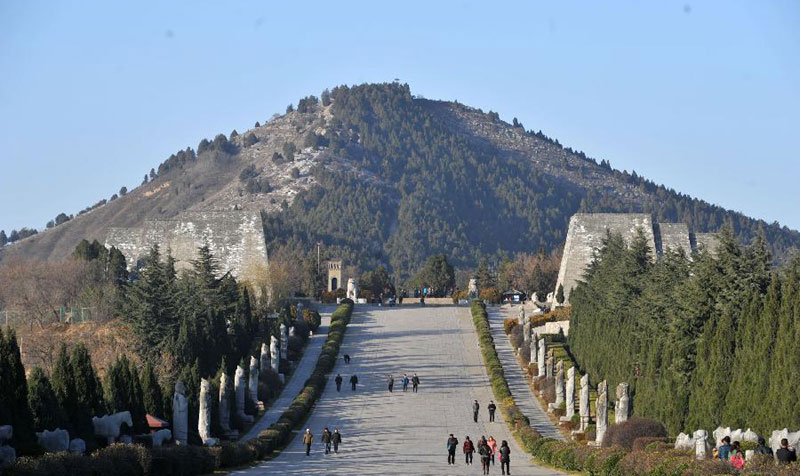
Qianling_Mausoleum_Scenic_Area.
The Legacy of Wu Zetian
At the heart of Qianling lies the mausoleum of Wu Zetian, China’s only female emperor, who reigned from 690 to 705 AD. Her rise to power is a remarkable tale of ambition and cunning. Originally a concubine to Emperor Li Shimin, she defied the conventions of her time to become the wife of his son, Emperor Gaozong. After his death, she consolidated power, ultimately declaring herself emperor in a male-dominated society.
Wu Zetian’s tomb, accompanied by that of her husband, Emperor Gaozong, is a striking symbol of her authority. The mausoleum itself is unapproachable, perched atop a mountain that resembles the figure of the empress, with the mountain’s contours symbolically representing her head, chest, and legs. This representation has given rise to the legend that the mountain embodies her spirit, eternally watching over her domain.
The Spirit Way and Its Guardians
The path leading to the mausoleum, known as the Spirit Way, is lined with stone statues that represent various figures from the Tang court, including generals and foreign dignitaries. Visitors are often struck by the formidable presence of these statues, many of which are now headless, evoking questions about their historical significance. Some legends suggest that these figures were once vibrant guardians of the empress, tasked with overseeing her journey into the afterlife.

Qianling_Mausoleum_Scenic_Area.
Among these stone sentinels lies a blank stela, shrouded in mystery. The absence of inscriptions has led to various theories, with some believing it symbolizes forgotten history, while others interpret it as a deliberate choice to honor Wu’s enigmatic legacy.
Exploration of the Surrounding Area
The Qianling Mausoleum Scenic Area is not just about the mausoleum itself; the surrounding landscape is rich with history and beauty. The region features numerous satellite tombs, which house intricate wall paintings and artifacts from the Tang Dynasty. Although many of these sites remain unexplored to ensure their preservation, the stories they hold are palpable, waiting for adventurous travelers to uncover them.
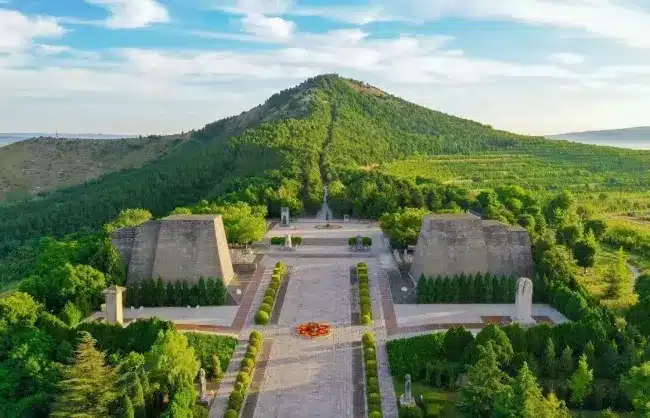
Qianling_Mausoleum_Scenic_Area.
For those looking to immerse themselves in the natural beauty of the area, options abound, including hiking and horseback riding among the picturesque hills. The scenic backdrop enhances the experience, making it an ideal location for photography and reflection.
A Hidden Gem for Travelers
Unlike many other historical sites in China, Qianling Mausoleum offers a more tranquil experience, far removed from the bustling crowds of major tourist attractions. This serene environment invites visitors to delve deeper into the rich tapestry of Tang Dynasty history, allowing for moments of quiet contemplation in the shadow of legends.
As you wander through this historical haven, take a moment to read up on the tales of Wu Zetian and the significance of the figures along the Spirit Way. Understanding the legends and history will enrich your visit, transforming it from a simple sightseeing trip into a profound journey through one of China’s most fascinating epochs.
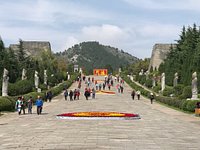
Qianling_Mausoleum_Scenic_Area.
In conclusion, the Qianling Mausoleum Scenic Area is more than just a resting place for emperors; it is a vibrant chapter in the annals of Chinese history, steeped in legends and surrounded by breathtaking natural beauty. Whether you are a history enthusiast or simply seeking a unique travel experience, Qianling promises an unforgettable glimpse into the past.
Main Highlights: What You Absolutely Can’t Miss
Discovering the Wonders of Qianling Mausoleum Scenic Area
The Qianling Mausoleum Scenic Area is a treasure trove of history and a stunning testament to the grandeur of the Tang Dynasty. Nestled in the picturesque Lianshan Mountain, this site offers a remarkable journey into the life of one of China’s most enigmatic figures, Empress Wu Zetian, and her husband, Emperor Gaozong. Here are the must-see highlights you absolutely cannot miss during your visit.
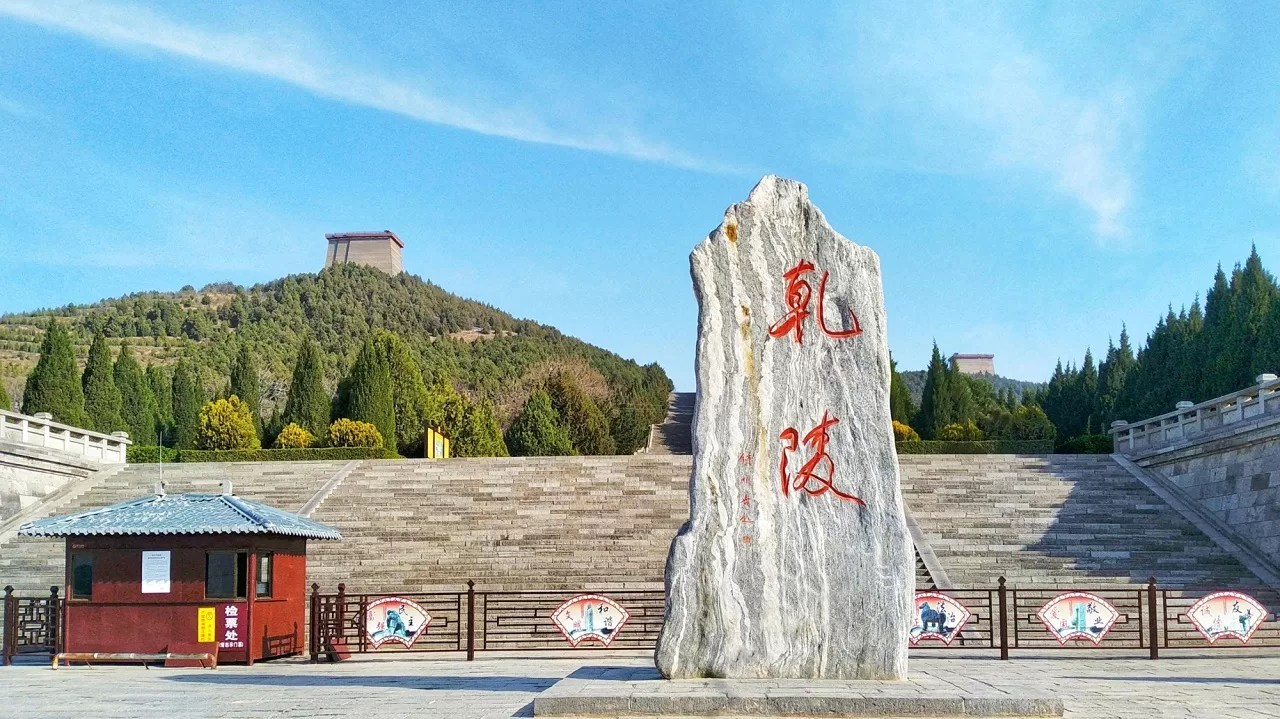
Qianling_Mausoleum_Scenic_Area.
1. The Majestic Tomb of Wu Zetian and Emperor Gaozong
At the heart of the Qianling Mausoleum lies the tomb of Empress Wu Zetian, the only female emperor in Chinese history. Her dramatic rise from concubine to sovereign is reflected in the grandeur of her final resting place. While the tomb itself remains sealed—preserving its mysteries—you can hike up to the summit of the pyramid-shaped mound for breathtaking views of the surrounding landscape.
2. The Spirit Way
As you approach the main tomb, be sure to walk along the Spirit Way, a ceremonial path lined with beautifully crafted stone statues from the Tang era. The statues depict generals, foreign dignitaries, and even headless figures, each a silent witness to the reverence bestowed upon the emperor and empress. This pathway is not only a visual delight but also a poignant reminder of the customs surrounding death and the afterlife in ancient China.
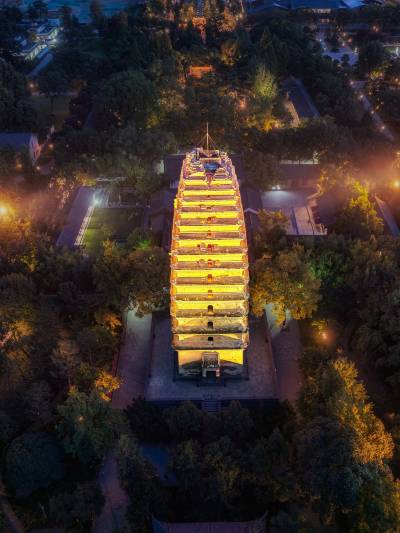
Qianling_Mausoleum_Scenic_Area.
3. The Satellite Tombs
Adjacent to the main mausoleum, visitors can explore three of the satellite tombs, which house well-preserved murals, ornate decorations, and the sarcophagi of various nobles. Each tomb offers a glimpse into the artistic excellence of the Tang Dynasty and the elaborate burial practices of the time. The intricate wall paintings provide a vivid narrative of life during this golden age of Chinese history.
4. Qianling Museum
A visit to the Qianling Museum is essential for history enthusiasts. The museum showcases a wealth of artifacts unearthed from the mausoleum and surrounding areas, offering insights into the daily life and spiritual beliefs of the Tang Dynasty. Exhibits include pottery, textiles, and ceremonial items that illuminate the era’s cultural richness.
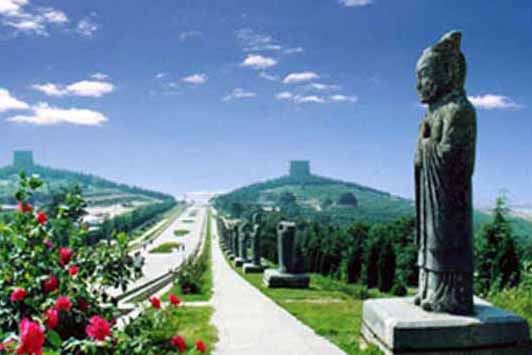
Qianling_Mausoleum_Scenic_Area.
5. Scenic Hiking Trails
Beyond the historical sites, the scenic area is bordered by stunning mountains that beckon to outdoor enthusiasts. Consider taking one of the hiking trails that wind through the picturesque landscape. These trails not only offer a chance to connect with nature but also provide panoramic views of the mausoleum and the surrounding hills—perfect for photography enthusiasts.
6. Horseback and Camel Riding
For a unique experience, opt for horseback or camel riding in the hilly areas surrounding the mausoleum. This adventurous activity adds an exciting dimension to your exploration, allowing you to immerse yourself in the natural beauty of the region while following ancient paths once traveled by imperial couriers.
7. Tips for Your Visit
- Best Time to Visit: The mausoleum is best enjoyed in good weather. Plan your visit during spring or autumn for pleasant temperatures and clearer skies.
- Accessibility: There are limited amenities, so come prepared with water and sun protection as there’s little shelter from the elements.
- Transportation: The scenic area is accessible via a local tourist bus from Xi’an, offering a convenient and affordable commute.

Qianling_Mausoleum_Scenic_Area.
Visiting the Qianling Mausoleum Scenic Area is not just a trip through ancient history; it’s an opportunity to stand in the presence of legends. With its rich tapestry of stories, stunning landscapes, and cultural significance, this site promises a memorable experience for any traveler keen on delving into China’s illustrious past.
Planning Your Visit: A Practical Guide
Discovering the Qianling Mausoleum Scenic Area
Nestled in the heart of China’s historical landscape, the Qianling Mausoleum Scenic Area is a treasure trove for travelers eager to explore the rich tapestry of Chinese history and culture. This site, which encompasses the mausoleum of the only female emperor in Chinese history, Wu Zetian, alongside her husband, Emperor Gaozong, offers a unique glimpse into the Tang Dynasty era. Here’s everything you need to know to plan a rewarding visit.
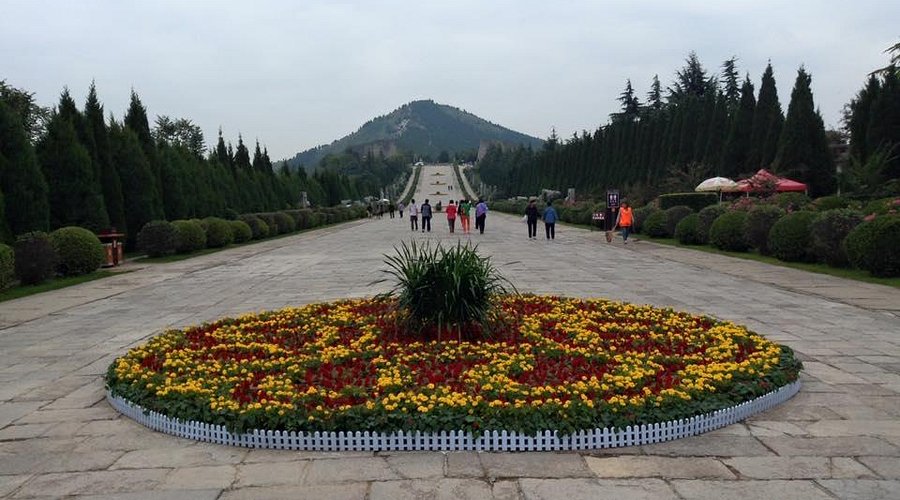
Qianling_Mausoleum_Scenic_Area.
Getting There
- Location: The Qianling Mausoleum is situated in Qian County, approximately 80 kilometers northwest of Xi’an, making it accessible for a day trip.
- Transportation:
- Tourist Bus: Take the No. 3 tourist bus from Xi’an Station. Buses are clearly marked with destinations and leave around 7:30 AM. Make sure to arrive early for a seat.
- Private Transport: Hiring a taxi or arranging for a private driver is another feasible option if you prefer a more flexible schedule.
Best Time to Visit
- Weather Considerations: The mausoleum is an outdoor site with limited shelter, so plan your visit on a clear day. Spring and autumn offer mild temperatures and stunning scenery, while summer may bring heat and humidity.
- Crowd Levels: Since the mausoleum is somewhat away from major urban centers, it tends to be less crowded than other tourist spots, allowing for a more peaceful exploration.
What to Expect
- Main Attractions:
- Emperor Gaozong and Empress Wu’s Tomb: The main mausoleum is a pyramid-shaped structure that you can admire from the outside, as the interior is off-limits.
- Satellite Tombs: Explore three of the 17 satellite tombs, which showcase well-preserved wall paintings, artifacts, and sarcophagi.
- Stone Statues: Stroll along the Spirit Way, lined with intricately carved stone statues of generals and dignitaries that once paid homage to the empress.
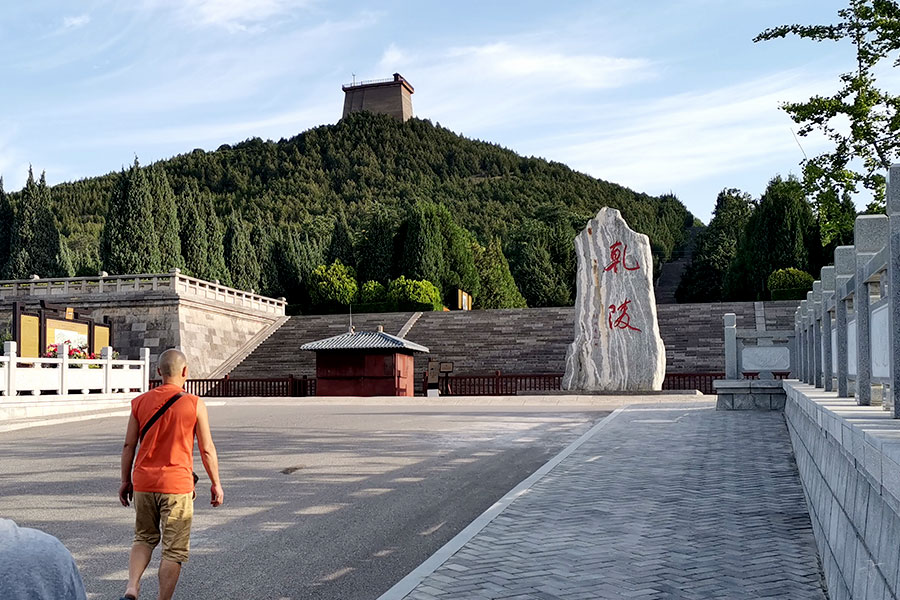
Qianling_Mausoleum_Scenic_Area.
Tips for a Great Visit
- Guided Tours: While hiring a guide can enhance your understanding of the site, many visitors recommend doing some research beforehand. Familiarizing yourself with Wu Zetian’s fascinating story and the significance of the tombs will enrich your experience.
- Dress Comfortably: Wear comfortable shoes as you will be walking on uneven terrain. Sunscreen and hats are advisable for sunny days.
- Explore the Surroundings: If time permits, consider a horseback or camel ride through the scenic hills. This is a fantastic way to appreciate the natural beauty surrounding the mausoleum.
Nearby Attractions
- Tomb of Emperor Gaozong: Just a stone’s throw away, delve deeper into the history of the Tang Dynasty at the tomb dedicated to Emperor Gaozong.
- Qian Mausoleum: Another burial site worth visiting, this area is rich in archaeological significance and ancient ruins.
- Local Cuisine: Don’t miss the chance to enjoy local delicacies at nearby restaurants or street food stalls after your visit.
Visitor Information
- Opening Hours: The Qianling Mausoleum is open daily from 8:00 AM to 6:00 PM.
- Entry Fees: Check for the latest entry fees and whether guided tours are offered at the ticket counter.

Qianling_Mausoleum_Scenic_Area.
As you explore the Qianling Mausoleum Scenic Area, take a moment to reflect on the remarkable life of Wu Zetian—a woman who defied the norms of her time and left an indelible mark on Chinese history. This journey into the past promises to be both educational and inspirational, inviting you to immerse yourself in the grandeur of a bygone era.
Tickets: Prices, Booking, and Tips
When planning your visit to the Qianling Mausoleum Scenic Area, a treasure trove of Tang Dynasty history, understanding ticket prices, booking procedures, and practical tips will enrich your experience. This majestic site, home to the tomb of the only female emperor in Chinese history, Wu Zetian, offers not just a glimpse into the past but also a chance to explore stunning landscapes.
Ticket Prices
- General Admission: The entrance fee to the Qianling Mausoleum is approximately ¥70 (around $10 USD) for adults.
- Discounted Tickets: Reduced rates are available for students and senior citizens, typically priced at ¥35 (approximately $5 USD). Be sure to carry valid identification to avail of these discounts.
- Additional Fees: Access to certain special exhibitions or guided tours may incur extra costs. For example, a guided tour of the museum can range from ¥200 to ¥380 (approximately $28 to $54 USD), depending on the level of service and duration.
Booking Your Visit
- Online Reservations: It is advisable to book your tickets in advance through the official Qianling Mausoleum website or authorized ticketing platforms. This helps avoid long queues, especially during peak tourist seasons.
- On-Site Purchase: Tickets can also be purchased at the entrance, but be prepared for potential wait times. Arriving early in the day can help you secure a ticket without much hassle.
Practical Tips for Visitors
-
Timing Your Visit: The mausoleum is open daily from 8:00 AM to 6:00 PM. For the best experience, consider visiting during the shoulder seasons of spring (April to June) or autumn (September to November) when the weather is mild, and the crowds are smaller.
-
Weather Preparedness: There is little shelter within the scenic area, so check the weather forecast before your visit. Bring sun protection or rain gear as necessary.
-
Getting There: If you’re traveling from Xi’an, the No. 3 tourist bus is a convenient and affordable option, costing around ¥12 (approximately $1.80 USD). The bus departs from Xi’an Station and runs regularly, but it’s wise to check the schedule in advance.
-
Guided Tours: While self-exploration is encouraged, consider joining a guided tour for deeper insights into the history and significance of the site. Tours often include extra features like visits to nearby attractions, enhancing your overall experience.
-
Respect the Site: As a major historical site, it is essential to maintain respect for the cultural heritage of Qianling. Keep noise to a minimum and follow the guidelines provided by the staff to help preserve this magnificent area for future visitors.
Conclusion
Visiting the Qianling Mausoleum Scenic Area is not merely an excursion; it’s an immersion into the rich tapestry of Chinese history and culture. With these ticketing details and practical tips, you’re well-equipped to make the most of your journey into the heart of the Tang Dynasty.
How to Get There: A Complete Transportation Guide
Navigating Your Way to Qianling Mausoleum Scenic Area
Visiting the Qianling Mausoleum Scenic Area, the final resting place of the illustrious Empress Wu Zetian, is a journey steeped in history and cultural significance. The mausoleum is nestled among the picturesque Lianshan Mountains in Qian County, offering not only a glimpse into the past but also breathtaking natural beauty. Here’s how to make your way there seamlessly.
Getting to Qianling from Xi’an
By Bus:
– Tourist Bus No. 3: The most convenient way to reach Qianling from Xi’an is by taking the No. 3 tourist bus. The bus departs from the Xi’an Railway Station and is clearly marked with English signage.
– Cost: Approximately ¥15 (about $2) per person.
– Schedule: Buses typically leave around 7:30 AM. It’s advisable to arrive early to secure a good seat, as these buses can fill up quickly.
– Return Journey: Be mindful of the return schedule as there are limited options for public transport after the last bus departs.
By Taxi:
– Taxis are available in Xi’an, but this option can be more expensive. Make sure to have your destination written in Chinese (乾陵) to show the driver, and expect to pay around ¥100–150 (about $15–23) for a one-way trip.
Exploring the Scenic Area
Once you arrive at the Qianling Mausoleum Scenic Area, the site is well organized with clear signage in English, guiding you to the various attractions including:
– The Main Tombs: You cannot enter the main tomb of Empress Wu Zetian and Emperor Gaozong, but you can admire the impressive structure from the base.
– Satellite Tombs: Several smaller tombs are accessible, showcasing well-preserved wall paintings and artifacts.
– Spirit Way: A beautiful path lined with stone statues leading to the tombs that reflect the grandeur of the Tang Dynasty.
Tips for Your Visit
- Weather Considerations: The mausoleum area lacks shelter, so plan your visit according to the weather. Ideal conditions are crucial for an enjoyable experience.
- Prepare for Walking: Wear comfortable shoes, as there is a fair amount of walking involved to explore the extensive grounds.
- Guided Tours: While it’s possible to explore on your own, guided tours can enrich your experience with historical insights. Consider booking a local guide or joining a group tour that includes transportation and entry fees.
Nearby Attractions
If you have extra time, consider visiting other nearby historical sites, such as:
– Tomb of Emperor Tang Gaozong: A short walk from the mausoleum, this site offers additional context to the life and times of the Tang Dynasty.
– Yongtia Princess Tomb: Located about 1.5 miles away, this tomb is another testament to the rich history of the area.
Final Thoughts
Visiting the Qianling Mausoleum Scenic Area is more than just a trip; it’s an exploration of the profound legacy of one of China’s most remarkable figures—Empress Wu Zetian. With this transportation guide, you are well-equipped to embark on a journey through history in one of China’s most captivating destinations. Safe travels!
Local Cuisine and Accommodation Nearby
Savoring Local Flavors and Finding Comfort Near Qianling Mausoleum
As you journey to the Qianling Mausoleum Scenic Area, immerse yourself in the rich tapestry of local cuisine and comfortable accommodations that enhance your exploration of this historical site. The region surrounding the mausoleum is not only steeped in history but also offers a delightful culinary experience and inviting places to rest.
Culinary Delights
-
Biang Biang Noodles
A highlight of the local gastronomy, Biang Biang noodles are renowned for their thickness and chewy texture. Served with an array of toppings, including spicy chili oil, vegetables, and meat, this dish provides a hearty and satisfying meal. Consider visiting Yangguang Noodle House in nearby Qian County, where you can watch the chefs hand-pull these delicious noodles. -
Rou Jia Mo (Chinese Hamburger)
Another must-try is the Rou Jia Mo, a flavorful Chinese-style hamburger made of shredded pork, beef, or lamb stuffed into a thick flatbread. Qianling Street Food Market offers various vendors who specialize in this popular snack, perfect for a quick bite after exploring the mausoleum. -
Local Snacks
Don’t miss out on the array of street food available in the area. From spicy skewers to sweet sesame cakes, the market stalls around the mausoleum are bustling with vendors eager to share their local specialties. These snacks provide a wonderful way to sample the flavors of the region while mingling with locals.
Comfortable Stays
-
Qianling Hotel
Located conveniently near the scenic area, the Qianling Hotel offers comfortable accommodations with stunning mountain views. The hotel features modern amenities, and its restaurant serves a mix of local and international dishes, ensuring a pleasant stay. -
Tang Dynasty Hotel
For a more cultural experience, consider the Tang Dynasty Hotel, which is designed to reflect the architectural style of the Tang era. This hotel provides guests with an authentic ambiance while still offering all modern conveniences. Its proximity to the mausoleum makes it an ideal base for exploration. -
Guesthouses
If you prefer a more intimate experience, several guesthouses in the area offer a cozy atmosphere with personalized service. Lianshan Guesthouse is popular among travelers for its warm hospitality and home-cooked meals, allowing guests to experience local life firsthand.
Conclusion
Exploring the Qianling Mausoleum Scenic Area is not just about delving into the depths of Chinese history; it’s also a chance to savor the local cuisine and enjoy comfortable accommodations. Whether you’re indulging in the famed Biang Biang noodles or resting in a Tang-style hotel, every moment adds to the rich tapestry of your travel experience in this culturally significant region.
Frequently Asked Questions
Frequently Asked Questions about Qianling Mausoleum Scenic Area
1. What is the Qianling Mausoleum Scenic Area?
The Qianling Mausoleum Scenic Area is the burial site of Emperor Gaozong and his wife, the only female emperor in Chinese history, Wu Zetian. Located in the Lianshan Mountain range, this historical site not only features the grand tombs but also offers insights into the Tang Dynasty’s culture and artistry through its impressive sculptures and burial practices.
2. How do I get to Qianling Mausoleum from Xi’an?
To reach Qianling Mausoleum from Xi’an, you can take the No. 3 tourist bus from Xi’an Station, which is clearly marked in English. The bus operates for an affordable fare, and it’s recommended to arrive early to secure a seat, especially during peak tourist season.
3. What are the opening hours of the Qianling Mausoleum?
The Qianling Mausoleum is open from 8:00 AM to 6:00 PM daily. Be sure to check the weather before your visit, as there is limited shelter in the area.
4. Is there a guide available for tours of the mausoleum?
While there are no mandatory guided tours, hiring a local guide can enhance your experience, providing rich historical context. Alternatively, you can do some prior reading to familiarize yourself with Wu Zetian’s fascinating story and the significance of the site.
5. What should I wear and bring for my visit?
Comfortable walking shoes are recommended since the area is expansive and may require a fair amount of walking. Additionally, consider wearing sun protection like hats and sunscreen, as there is minimal shelter from the elements. Bringing a water bottle is also advisable, particularly during the warmer months.
6. Are there facilities available at the Qianling Mausoleum?
The area has basic amenities, including restrooms and some food stalls. However, it is less commercialized than other tourist spots, so it’s wise to bring snacks and drinks if you plan to explore for several hours.
7. Can I explore the tomb interiors?
Access to the main tomb of Wu Zetian and Emperor Gaozong is restricted to protect the site. However, visitors can explore three of the satellite tombs, which contain well-preserved wall paintings and artifacts, offering a glimpse into the burial customs of the Tang Dynasty.
8. Are there any nearby attractions worth visiting?
Yes! The Qianling Mausoleum is surrounded by several other historical sites, such as the Tomb of Emperor Tang Gaozong and various ancient ruins. If time permits, consider a horseback or camel ride in the scenic hills nearby for a unique perspective of the area.
Final Thoughts on Your Trip
As you wrap up your journey through the Qianling Mausoleum Scenic Area, take a moment to reflect on the rich tapestry of history and culture that surrounds you. This enchanting site, resting in the serene embrace of the Lianshan Mountains, is not just a mausoleum but a testament to the remarkable life of Empress Wu Zetian, the only female emperor in Chinese history.
A Journey Through Time
Your exploration of Qianling is a journey back to the Tang Dynasty, a period marked by innovation, cultural flourishing, and political intrigue. As you wander through the grand tombs and admire the intricate stone carvings that once honored emperors and dignitaries, you can almost hear the whispers of history echoing through the ages. The stories of ambition and power, of love and loss, are etched in every corner of this majestic site.
Embrace the Beauty of Nature
The scenic area around the mausoleum is equally captivating. With its lush mountains and tranquil paths, it invites you to connect not only with the past but also with the natural beauty that surrounds you. Take a moment to breathe in the fresh mountain air, marvel at the stunning landscapes, and perhaps even glimpse the figure of Wu Zetian as it is said to appear on the mountainside—a striking reminder of her enduring legacy.
Prepare for Your Next Adventure
Before you leave, consider diving deeper into the history of this site. Engaging with local guides, reading up on the fascinating tales of the Tang Dynasty, or simply allowing the ambiance to inspire your thoughts can enrich your experience. Remember to check the weather, as the open nature of the area offers little shelter from the elements.
As you depart from Qianling, carry with you not just the memories of what you have seen, but a renewed appreciation for the complexities of Chinese history and the powerful figures who shaped it. Each step in this ancient land is a step through time, and your journey here will undoubtedly linger in your heart and mind long after you’ve returned home. Safe travels!